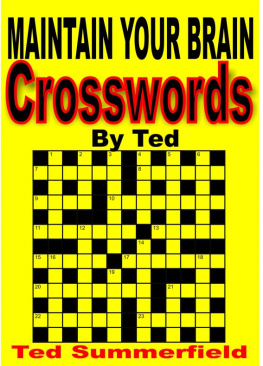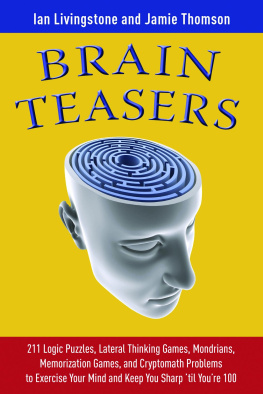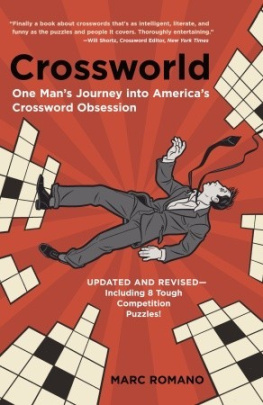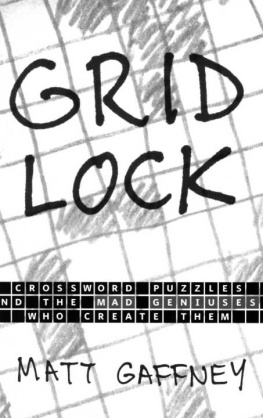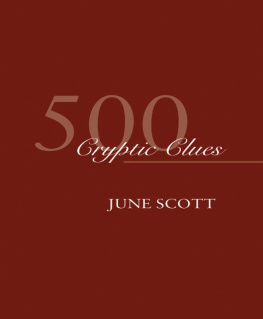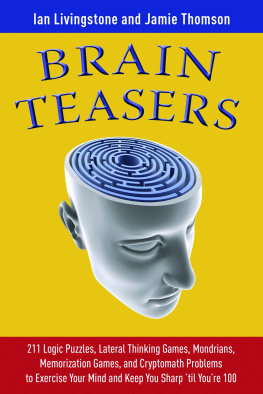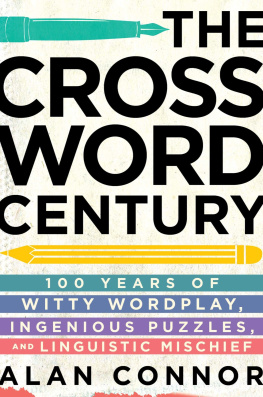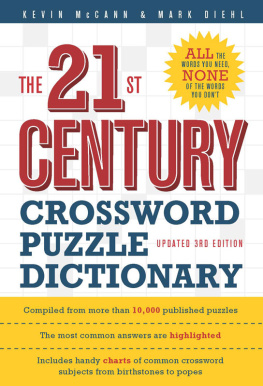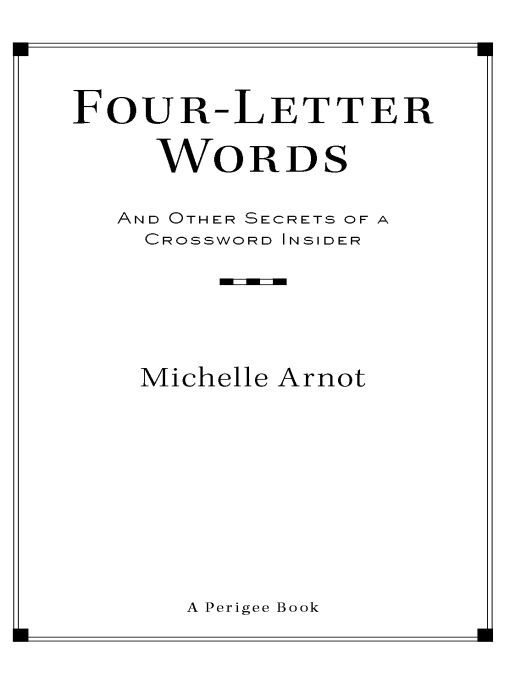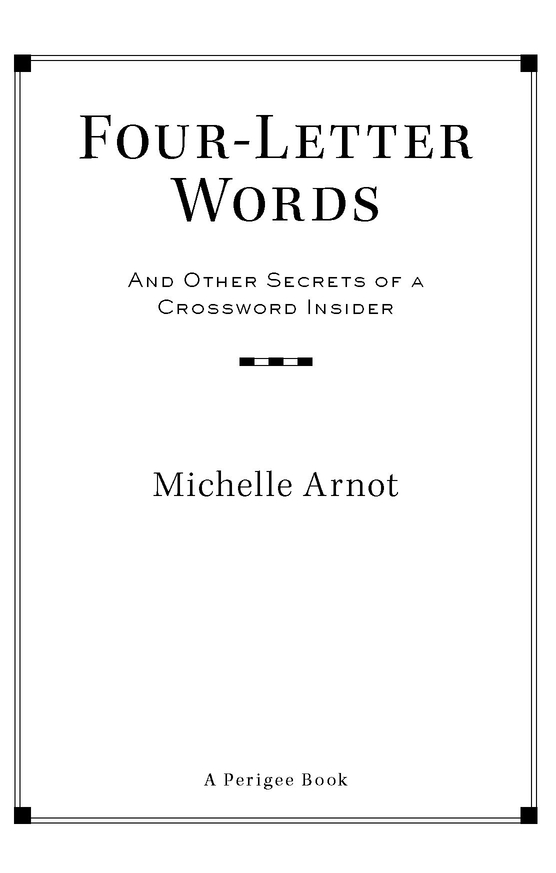Table of Contents
Praise for Michelle Arnot
One of the clearest, liveliest, and most entertaining writers in the world of puzzles.
Will Shortz, crosswords editor of the New York Times
Beginners and pros alike will enjoy Michelle Arnots insight into the worlds greatest pastime.
Marilynn Huret, www.garfieldgames.com
Michelle Arnot really knows the world of puzzles.
Janis Weiner, editorial director of Kappa Puzzle Group
A PUZZLE A DAY: Adventures with Crosswords
You must have a great vocabulary!
New acquaintances often exclaim this, to my embarrassment, when they learn that Ive served as editor and publisher of dozens of national puzzle magazines over the past two decades. If I had a nickel for each time I have heard that remark, Id be able to make a down payment on a Park Avenue AERIE (puzzle clue: Penthouse). Most people assume I am a walking dictionary due to my years as an acrossionado, to use a word I made up to describe my career as editor of five volumes of Crosswords for Dummies and many years with the Kappa Puzzle Group (over a hundred publications, including the four-color Games magazine, New York Times editor Will Shortzs old stomping ground).
The embarrassing truth is that my vocabulary is disproportionatelyskewed toward four-letter words. Not the naughty ones that have made themselves at home in print nowadays but the cute, oddball four-letter words that grout the grids of American crosswords. Puzzle solvers recognize that the basic lingo of the daily grid consists mainly of unspoken words, phrases, and even fragments. Due to the peculiarities of their letter structure, four-letter-type words prop up the puzzle. Getting to know as few as twenty-five of these handy words can boost ones solving abilities significantly, not to mention ones ego and brain power: four-letter words like OGEE (puzzle clue: Curved molding) and TSAR (puzzle clue: Ivan, for one); the ABBA, BETA, and FALA vowel-heavy combinations that give those in the know a jump-start. I write the answers in all capital letters because upper-case letters are the currency of crosswords. No cursive in this world; back to grade-school letters that are legible in their little boxes.
Undoubtedly, Miss Wohl, my third-grade teacher, had no inkling how studying the crossword in my Weekly Reader would ultimately determine my livelihood. Even then, I tried my hand at creating puzzles for a class magazine that I co-edited with my best friend. I got some things right, like ending a word with a black square, interlocking words across and down, and checking the spelling of the words I selected. But I didnt yet understand that crossword grids have specifications and that their patterns are symmetrical.
As youd expect from a compulsive solver, my hobby won me a spelling bee prize from The Journal American. Yes, I was (and continue to be) a confirmed bookworm, fascinated by the way grids weave words together in black and white. Four-letter words appeal to me. Call me a word NERD (puzzle clue: Egghead sort), but ever since 1977, when New York Times crossword editor Eugene T. Maleska paid me $20 for my first crossword, I have become fluent in crossword clichs.
I am an alumna of the Weng school of puzzle solvers, a short-lived era by crossword standards. Weng is the editor Will Weng, clue stylist at the New York Times in the 1970s. At the time, I was enrolled in a New York City high school. It didnt take long to bond with the puzzle lovers among my classmates. From that moment, I embarked on a lifelong dialogue with the puzzle-solving community. My schoolmates and I giggled or groaned over Wengs clues. Organs often lent (EARS), First Ladys first name (BESS), Barnums egress (EXIT), and Act of a sort (RIOT) had us in stitches. Whimsical Weng reeled me in with his sly humor. How quaint my compulsion seems by contrast with the way todays teens spend down time with texting, using AOL Instant Messenger, or listening to an IPOD (puzzle clue: Song holder)!
What a frisson when I discovered that the chairman of the history department at my high school, E. Ira Marienhoff, contributed to the puzzle page. In the dark ages of the 1970s, twenty years before the New York Times introduced bylines to the crossword, I stumbled upon this juicy Morsel (ORT, as puzzle solvers call it) while absorbed in a New York Times crossword before class. By contrast to twenty-first-century teachers, educators during the era of HAIR (1968 rock musical) kept students at arms length. The only tidbit we had on Marienhoff was that he lived with his mom. The other publicly known fact about the man is that he left an unexpectedly significant endowment to Yeshiva University in 1994, which generated some local publicity.
Upon seeing me with the puzzle, Marienhoff revealed that he was its author. That was my lightbulb moment: A high school teacher could make up a puzzle and get it published. He told me that the editor sent out guidelines upon request and that anyone could make one up and submit it. This became the lesson from A.P. history that influenced the course of my adulthood. No telling how what you hear in the classroom may direct you down the road.
Not until graduate school at Columbia University did I take the time to craft a puzzle and mail it in with a SASE (puzzle clue: Ms. enclosure), as publishers refer to the self-addressed stamped envelope. By then Maleska had succeeded Weng. Maleska, a former high school administrator and a poet, had sent me guidelines with a handwritten note in which he expressed excitement that a young person was entering the field because most of his regular contributors were retirees. He worried that the field would suffer without new blood and inquired whether I had heard of a graduate student in the Midwest, a prolific puzzle constructor by the name of Will Shortz. That surname made an impression on me, as it has since on millions of crossword fans.
Mimeographed sheet in hand, I invested in the primitive tools of a constructor from the Jimmy Carter era: lead pencil, clean eraser, and a packet of graph paper. The guidelines informed me that the grid for a daily crossword measures 15 X 15 squares, of which no more than one-sixth are black. Next, I thought up a theme (the common thread that typically connects the three longest horizontal entries in the grid). I studied the various designs and adapted one that worked with my theme. Then I scribbled and erased for a week.
Later that year my submission appeared in print. It was on a Tuesday, I believe, which experienced solvers understand means it was on the easy side. (The New York Times crossword ramps up after Wednesday to the Saturday hair puller. Some of my closest friends dont even bother with a New York Times crossword before Thursday.) For my weeks labor in 1977 I received a check in the amount of $20. By the time Shortz took the reins of the Times puzzle in 1993, daily constructors received a whopping $50. Thanks to Shortzs lobbying, as of June 2007 the price tag on a daily puzzle is now $200. Of course, todays tools of the tradea computer and the Internetrequire a much greater investment than my modest tools. For a Sunday crossword, the


